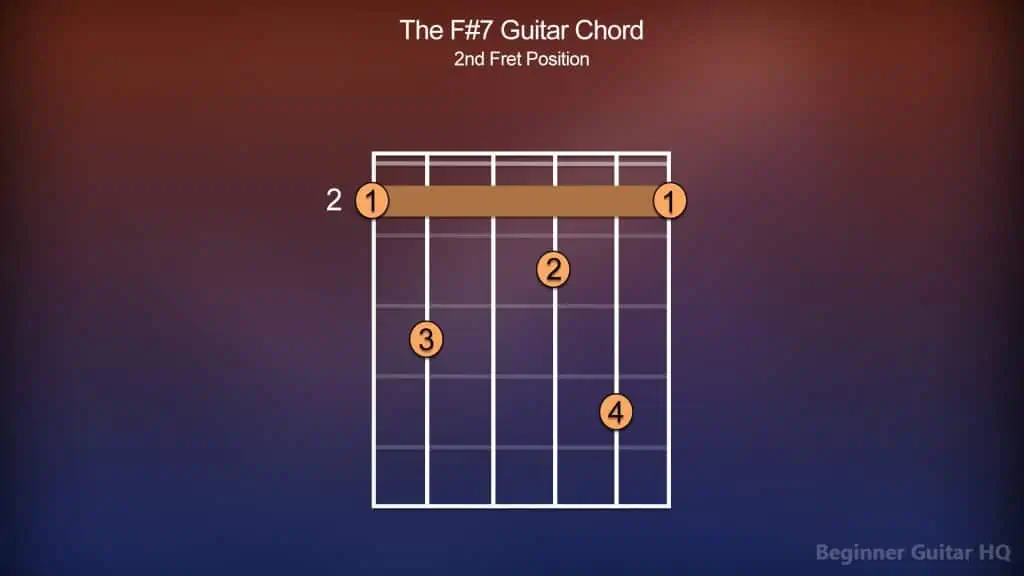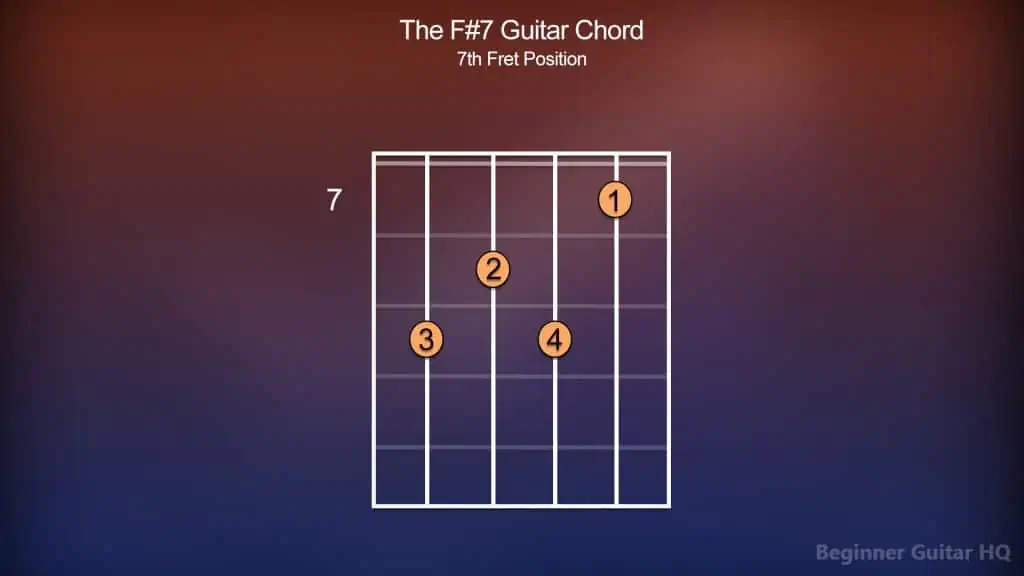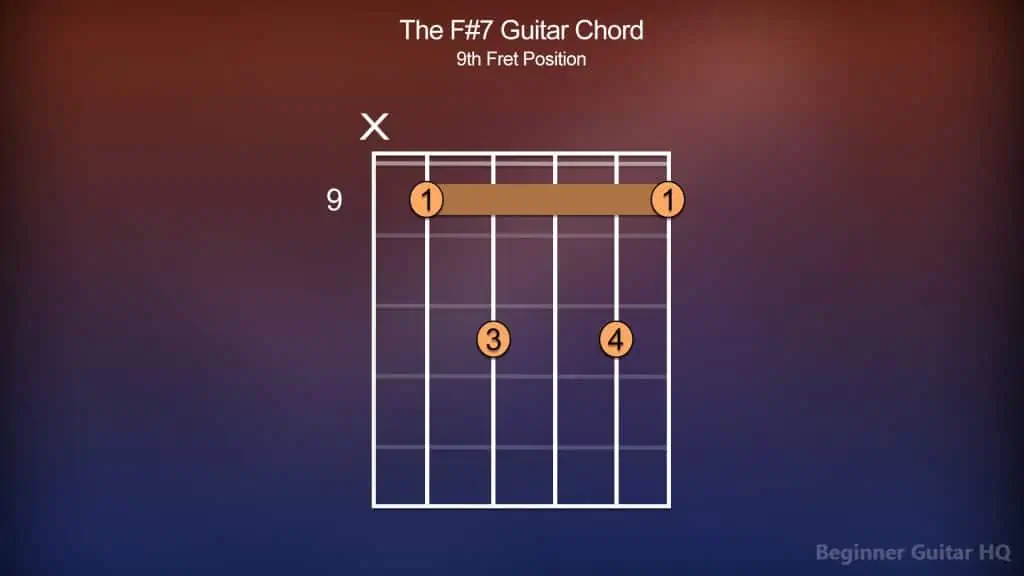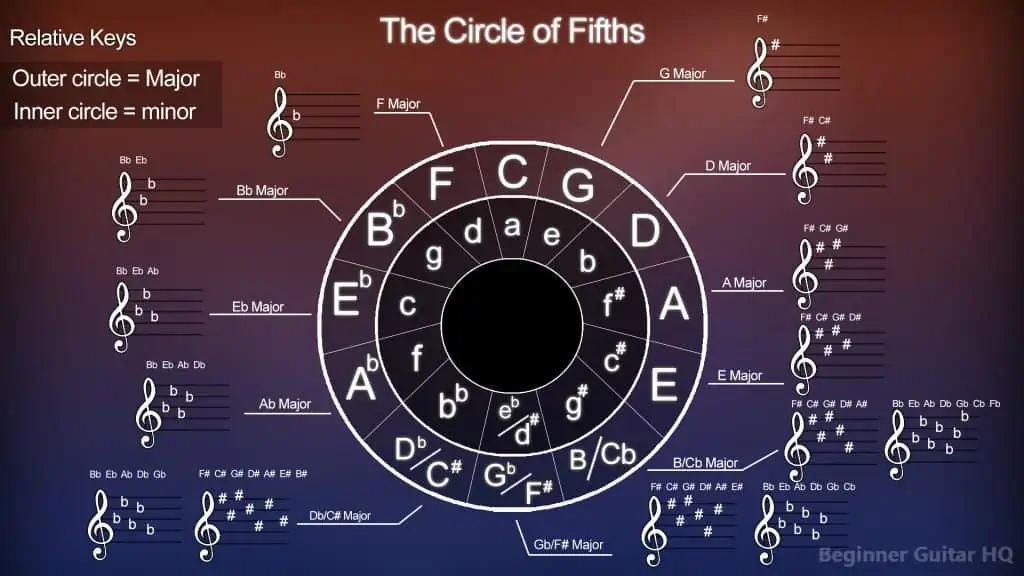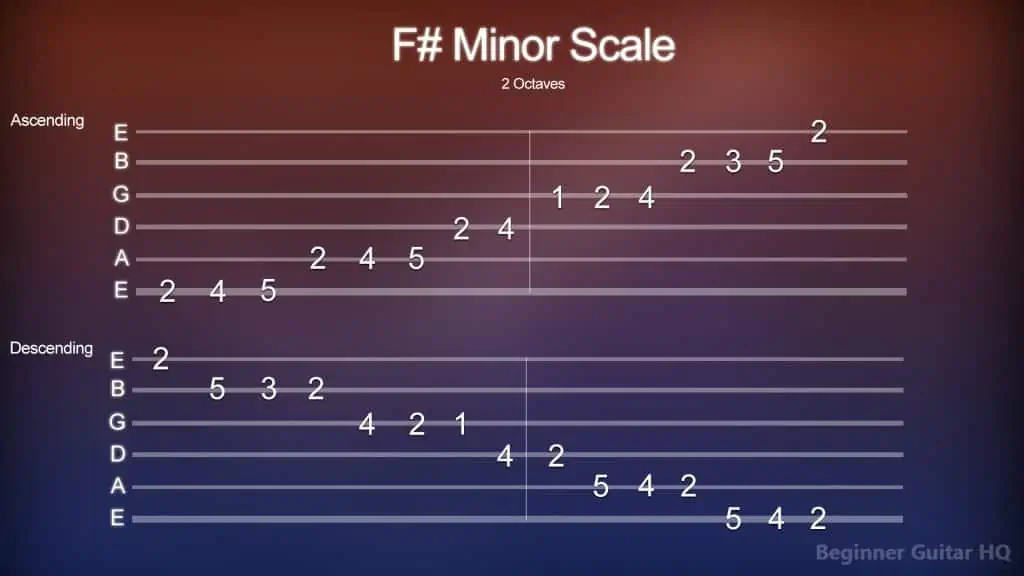The F#7 chord is one of many great-sounding seventh chords you can play on the guitar. In fact, many popular songs you probably know use these seventh chords. Songs like, “Jeff Buckley’s – Hallelujah”, “John Lennon’s – Imagine”, and even “Frank Sinatra’s – Fly Me To The Moon” use these colorful chords. As you read on, we’ll cover all that you need to know about our F#7 chord and how you can start using it today. Let’s dive in!
Contents
How to Play the F#7 Chord
As a fair warning to beginners, the variations shown below for the F#7 chord are a bit tricky, as you will either be required to form a “barre”, or use all four of your fingers to complete the chord. Nevertheless, the important thing is to keep practicing and not get discouraged! If you need to make things easier, playing the F# major chord can be an excellent way to ease into this seventh chord.
Chord chart of the F#7 chord from 2nd fret position.
Chord chart of the F#7 chord from the 7th fret position.
Chord chart of the F#7 chord from the 9th fret position.
Trouble With Chord Charts?
You might be scratching your head in confusion if this is your first time seeing a chord chart. Don’t worry, these are very easy to learn! Let’s bring our attention to the big rectangular box containing a bunch of vertical and horizontal lines. This is a visual representation of our fretboard! Each of the vertical lines running down it represents a different string on the guitar. From left to right, we have our low E, A, D, G, B, and high E strings. The horizontal lines, however, are what separates one fret from the next.
On the strings, within the frets, you will see numbers anywhere from 1 – 4. These numbers represent different fingers to be used in order to complete our chords. The number 1 is for your index finger. The number 2 is for your middle finger. The number 3 is for your ring finger. Finally, the number 4 is for your pinky finger. You might also see a bar stretching across the various strings. This represents a “barre”, needed to form a “barre chord”. To form a barre, you need to drape your index finger across several strings along an individual fret, making sure to apply pressure to the strings.
At the top of our fretboard, above the strings, we might see the symbols, “O” or “X”. The “O” represents an open note, (a string to be played but not fretted). However, if you have an “X”, that indicates that you are to not play the string in order to complete the chord. Lastly, in some cases, you might see a number off to the side of our fretboard. The number represents the fret we’re starting on for forming our chord. However, if there is no number present, it’s generally implied that we’re starting from the open note position.
Breakdown of the F#7 Chord
Seventh chords typically carry a soft, and bluesy sound, which is no surprise as they’re commonly used in the genres of Jazz and Blues music. However, what actually is a seventh chord? A seventh chord can be defined as a triad with an additional interval of a seventh slapped on top. Before we go into that, we should cover some of the essentials of our current key; F#.
The Key of F# Major
Let’s start with our key. Our key can be defined as a grouping of musical pitches that form the foundation of a song or piece of music. What defines our musical pitches? That’s where our key signature comes into play. Every key has its own key signature. Our key signature contains various symbols, sharps (#) and flats (b), often spotted after the clef on a piece of sheet music. A note marked sharp is to be raised by a semitone, while a note marked flat is to be lowered by a semitone. However, it’s the trouble of finding what notes are to be sharp and flat in the desired key that creates the trouble. For those new to music theory, that’s where consulting the circle of fifths can help out.
Diagram of the circle of fifths showing all of the most commonly used key signatures.
The circle of fifths is a wheel-shaped diagram that displays all of our most commonly used keys and their corresponding key signatures. The outer ring houses all of our major keys, while the inner ring houses all of our relative minor keys (keys with a different root note, but share the same key signature). Starting from C major, going clockwise around the wheel, you’ll notice that every key gets an additional sharp in its key signature. However, as you go counterclockwise around the wheel, you’ll notice that every key gets an additional flat added to its key signature. Given that we’re focusing on F# major, with a key signature containing sharps, we’ll only focus on the right half of the wheel.
So, how do we determine which notes in each key become sharp? We follow a simple acronym: FCGDAEB. This stands for:
“Father, Charles’, Goes, Down, And, Ends, Battle”
The first letter of each word used within this saying represents a note that is to be sharp. For instance, if we wanted to find the key of D major, and we know D major has two sharps, then using our fingers, we would go: “Father, Charles…” and know that the sharps used within the key of D major are F, and C sharp. If we were in the key of E major, containing four sharps, then using our fingers again, “Father, Charles, Goes, Down…” Therefore, the key of E major contains the sharps, F, C, G, and D.
The idea is that you want to remember how many sharps each key has on the right side of the wheel. Remembering that can help you out with the rest!
F# Major Scale
Using our method from before, we know that our F# major scale has six sharps in its key signature: F, C, G, D, A, and E. Using this, we can now move on to forming our scale.
The F# major scale contains the sequence of notes:
F# > G# > A# > B > C# > D# > E# > F#
However, did you know that major scales have their own strict pattern of tones (T) and semitones (S) that they follow? Major scales follow this sequence:
T > T > S > T > T > T > S
Everything appears pretty normal as six of our seven notes have a sharp. In the third interval of our scale, A, which is normally a tone apart from B, moves closer by becoming A#. The notes B and C are usually a semitone apart until C becomes C# putting them a tone apart in the 4th interval of the scale. E and F are normally a semitone apart and continue to be as they both gain a sharp in this key, as you can see in the seventh interval of the scale.
Now, let’s try playing our F# major scale:
Guitar tablature of the F# major scale from open note position.
Trouble With Tablature?
Learning tablature, also known as “tabs”, is a very convenient alternative for those without a musical background, allowing us to share and learn some of our favorite songs and exercises. As you can see, there are six horizontal lines strewn out with a bunch of numbers. These lines represent each string on the guitar. From the bottom to the top, we have our low E, A, D, G, B, and high E strings. The numbers, however, represent the fret you need to play. For instance, if you see the number “1” on the low E string, that means you need to play the first fret of that corresponding string. If you see the number “4” on the D string, then you need to play the fourth fret of that corresponding string. If, however, you see the number “0” on a string, then that means you are required to play an open note on that string (a string to be played but not fretted).
It’s important to understand that there are some slight drawbacks to tablature. While the upside is it’s very convenient and easy to learn, the downside is that it most often lacks in detail when compared to musical notation. This lack of detail means it’s up to you the musician, to use your ear to fill in the gaps of how the song is intended to be played. Fortunately, while this may be inconsistent amongst all tabs, sometimes you may find a tab containing this additional information. Here are some of the symbols used to help musicians further understand how to play certain parts of tablature:
H = Hammer-on
P = Pull-off
B = Bend
X = Mute
PM = Palm Mute
\ = Slide Down
/ = Slide Up
~~~ = Vibrato
For self-taught guitarists learning most of their material from tablature or sheet music, it’s important to exercise good playing habits, primarily, fingerwork. Fingerwork is incredibly important to maintaining a steady flow between notes while making it easier for you to play your favorite songs, scales, and exercises. We place an emphasis on the importance of fingerwork because tablature and sheet music don’t often include details as to where you should be placing your fingers. As a guitarist, before playing sheet music or tabs, you should read ahead to help you prepare for the proper finger placement. This will help you eliminate any awkwardness or breaks within the song.
A good rule of thumb is to see what can fit within your hand. For instance, if you’re playing the F# major scale, the lowest fret we’ll play is on the 1st fret, while the highest is on the 4th fret, but we start on the 2nd fret. Therefore, it’s probably best that we start with our middle finger on the 2nd fret, play the 1st fret with our index, the 3rd fret with our ring finger, and our 4th fret with our pinky finger.
Scale Degrees
Now that we can play our F# major scale, let’s gain a further understanding of each of our notes within and the role that they play. Each of our heptatonic scales (scales consisting of seven notes), has seven scale degrees, each with its own unique identifier, making it easy for musicians to refer to them. Within F# major, here are each of the degrees:
- F# = Tonic (1st Degree)
- G# = Supertonic (2nd Degree)
- A# = Mediant (3rd Degree)
- B = Subdominant (4th Degree)
- C# = Dominant (5th Degree)
- D# = Submediant (6th Degree)
- E# = Leading Tone (7th Degree)
- F# = Tonic (1st Degree/Octave)
The first degree, our tonic can be thought of as our tonal center, the root note where things tend to resolve. The second degree, our supertonic, is an interchangeable degree with the 4th degree of our scale, as they share two of the same notes within their chords. The 3rd degree, our mediant, shares two notes with our tonic, which makes it a great degree for drawing out the tonic. The fourth degree is our subdominant. Sharing a note with our tonic, F#, this chord adds some slight tension to our chord progressions and scales. Naturally, the subdominant will advance to an even greater tension on our fifth degree, the dominant. This degree, next in importance to our tonic, shares one note in its triad with the tonic, but not the root note. Typically, our dominant, at the peak of our tension will resolve back home to our tonic. The sixth degree, the submediant is another excellent degree for drawing out our tonic, as they share two notes within their triads. Next, we have our seventh degree, the leading tone which is important in forming our 7th chords. This degree also holds a lot of tension, falling right below the tonic, an octave higher from where we began. Try playing our F# major scale and ending on E#. Your ears will want to hear it resolve to F#, our tonic.
Triads
Now that we have our F# major scale, and understand the different scale degrees, we can form our F# major triad. To form our F# major triad, we simply take our tonic, mediant, and dominant (1st, 3rd, and 5th degrees) of our F# major scale, and stack them on top of each other. Within the key of F# major, we get the notes: F#, A#, and C#.
Did you know, however, that our major triads have their own set of intervals that can help you identify them? Here are the characteristic intervals of a major triad:
- Major 3rd – Between the 1st and 3rd degrees. F# > A#.
- Minor 3rd – Between the 3rd and 5th degrees. A# > C#.
- Perfect 5th – Between the 1st and 5th degrees. F# > C#.
If, however, we wanted to turn our F# major triad into an F#7 chord, we would simply include an interval of a minor 7th from our tonic on top of our triad. This makes the notes of our chord: F#, A#, C#, and E.
Chords Compatible With F# major
Making a chord progression that we can enjoy is a challenge that all musicians face at one time or another. Thankfully, there is a method to make this endeavor easier using our triads. Let’s take each degree of our F# major scale and form triads over each one:
- F# major = F#, A#, C# (1st Degree)
- G# minor = G#, B, D# (2nd Degree)
- A# minor = A#, C#, E# (3rd Degree)
- B major = B, D#, F# (4th Degree)
- C# major = C#, E#, G# (5th Degree)
- D# minor = D#, F#, A# (6th Degree)
- E# diminished = E#, G#, B (7th Degree)
Remember how we mentioned before that each degree plays an important role? Let’s take a look at how this works in a couple of tried and true chord progressions in the key of F#:
I – IV – V
For this chord progression, we’ll be starting on our first degree, the tonic, the F# major chord. Things are calm, but we will now add some tension, by shifting to our fourth degree, the subdominant. This is our B major chord, sharing one note in its chord with our F# major chord, F#. Now, we will add even greater tension, by moving to our fifth degree, the dominant. This is our C# major chord, sharing a note with our tonic, however, not the F#, but the C#. Finally, we will resolve, returning to our tonic to do it all again. This three-chord progression contains these chords in sequence: F#maj, Bmaj, C#maj.
I – vi – IV – V
This chord progression will start on our tonic, F# major, yet again. However, this time, we will move to our sixth degree, the submediant, D# minor. This degree helps in drawing out our F# major chord as they both have two of the same notes in their respective chords, F#, and A#. Next, we will add more tension, moving to our subdominant, B major. This chord shares a note with F# major, F#, and two with D# minor, F#, and D#. You can see the tension being drawn out slowly here. Finally, we move to our peak of the tension, the dominant, C# major, sharing one note with our tonic, C#, but none with the subdominant. Now, we will resolve, returning home to our tonic to repeat the progression again. This four-note progression contains these chords in sequence: F#maj, Dmin, Bmaj, C#maj.
F# to F#m
Now that we’ve gotten a good handle on how our F# major chord works, what about its minor counterpart, F# minor? Let’s go over some of the key differences:
First, it’s important to note that the key of F# major and F# minor contain different key signatures. These keys share a parallel relationship, in which they both share the same tonic, but not the same key signature. This is unlike a relative-key relationship, in which the keys share the same key signature, but a different tonic like F# major to D# minor. The key of F# major contains these notes F#, C#, G#, D#, A#, and E# in its key signature, while the key of F# minor only contains F#, C#, and G#.
The difference in key signature results in a different-looking scale. Here is the scale for F# minor:
F# > G# > A > B > C# > D > E > F#
Minor scales contain their own strict pattern of tones (T) and semitones (S), much the way that major scales do. Here is the sequence for a minor scale:
T > S > T > T > S > T > T
Now, let’s try to play our F# minor scale:
Guitar tablature of the F# minor scale from open note position.
Using what we know about our F# minor scale, and the different scale degrees, we can now form our F# minor triad. Just as we did with our major triad, we will be taking our tonic, mediant, and dominant degrees of our scale (1st, 3rd, and 5th degrees). This gives us the notes: F#, A, and C#.
Our minor triads also contain their own characteristic intervals between their notes. Let’s see if you can spot the difference in retrospect to our major triad intervals:
- Minor 3rd – Between the 1st and 3rd degrees of our scale. F# > A.
- Major 3rd – Between the 3rd and 5th degrees of our scale. A > C#.
- Perfect 5th – Between the 1st and 5th degrees of our scale. F# > C#.
Did you notice it? In our minor triads, between the 1st and 3rd degrees, we have a minor 3rd, and between the 3rd and 5th degrees, we have a major 3rd. In a major triad, however, this gets flipped! Therefore, the notes are a major 3rd between the 1st and 3rd degrees, and a minor 3rd between the 3rd and 5th degrees. The perfect 5th remains the same in both.
If we want to make our F#m7 chord, we will do as we did before, by stacking an interval of a minor seventh from our tonic, on top of our triad. This gives us the notes: F#, A, C#, and E.
Conclusion
That’s all there is to it! Seventh chords can be a really great way of spicing up your chord progressions, by adding more character to your music. It can also be an excellent means of practice, by familiarizing yourself with different intervals, and challenging yourself with new chords! However, that is only the tip of the iceberg. How will you use this newfound chord? What other chords will you challenge yourself with? Will you try, the ninth, eleventh, or thirteenth chords? Wherever your endeavors take you, keep on rockin’!


